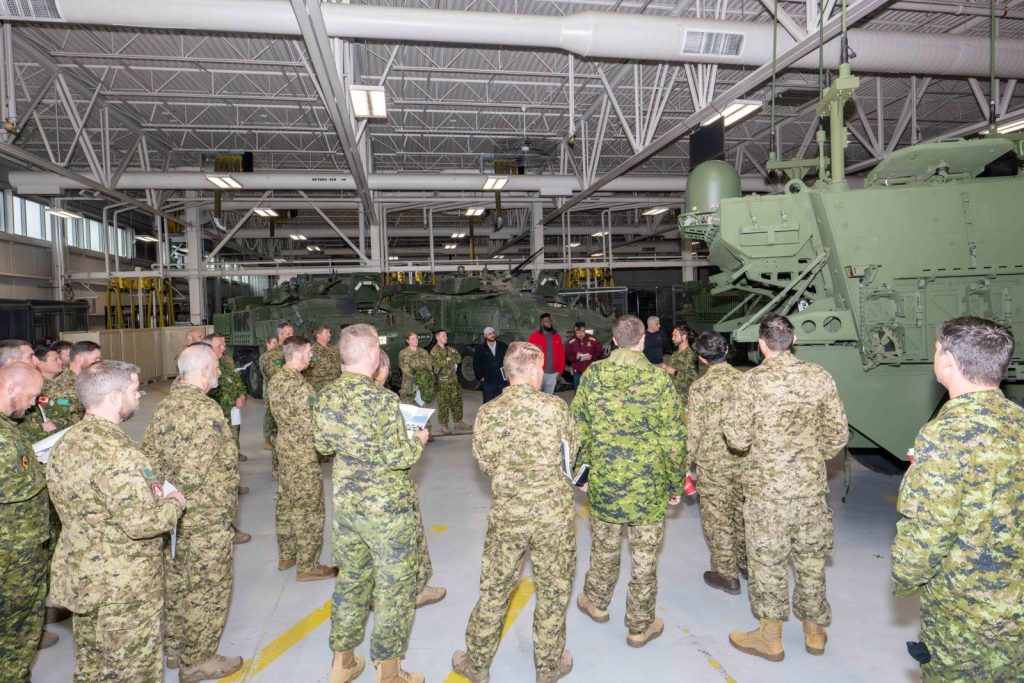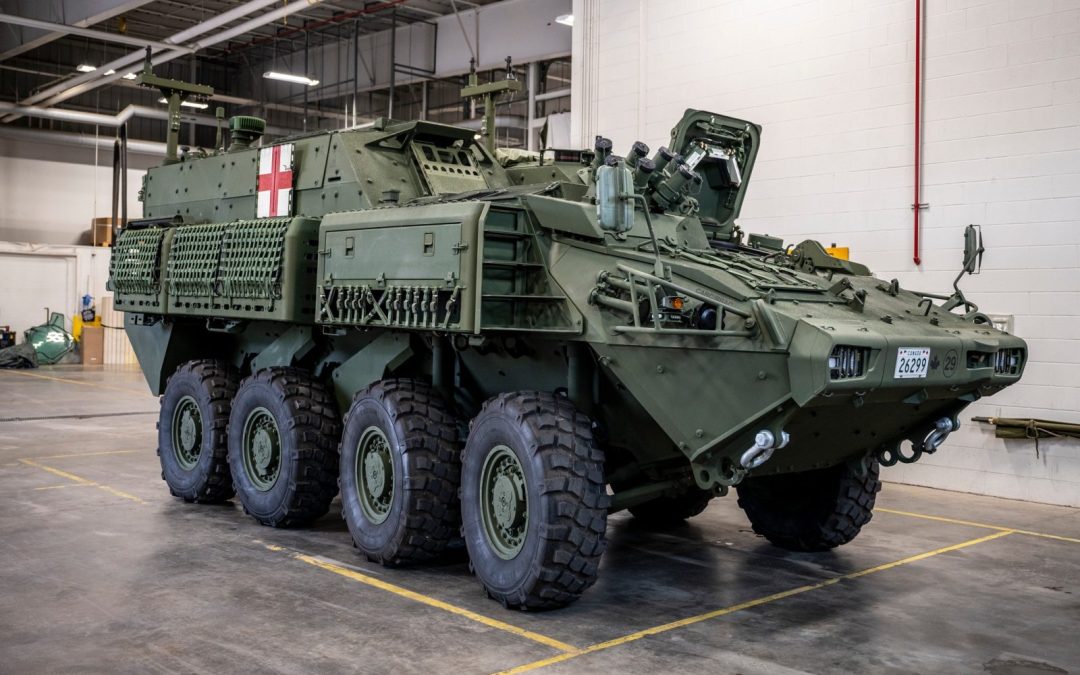by Ken Pole
Deployed troops, like civilians, likely have a common perception of ambulances. They appreciate that the vehicles and their highly trained crews are always ready and available. But they obviously hope never to need one themselves.
However, they can be the difference between life and death in combat and having the most up-to-date platform is critical. That’s why ambulance variants have been the first deliveries of the new Armoured Combat Support Vehicle (ACSV) project that will see a total of 360 vehicles in eight configurations delivered by General Dynamics Land Systems-Canada (GDLS-C).
Four years after the overall ACSV order was placed, the Army accepted the first four ambulances in late 2023 for the units that hosted the training. As of August 2024, 34 of a planned 49 had been delivered.
“We’re still in the implementation phase,” explained Major Phil Gartner, project director in the Directorate of Land Requirements’ Armoured Vehicle Systems. “Of the remaining 15 . . . we’ve been able to redirect five from the field force and send them directly to the Army Equipment Fielding Centre in Montreal to be prepared for deployment” to the Canadian-led multinational brigade in Latvia.
The process shaves months off the timeline because, “instead of sending a vehicle from (GDLS-C) to a field unit and then pulling that vehicle back, to send it to deploy, it’s easier to take the vehicle straight from the factory and send it to Montreal,” he said.
The last 10 ambulances to roll off the line represent the first 10, which were donated to Ukraine as part of a Canadian commitment in military assistance that now exceeds $4.5 billion, and includes Leopard 2 main battle tanks, anti-tank weapons, small arms, M777 howitzers and associated ammunition. Under Operation Unifier, Canadian soldiers also have trained more than 40,000 Ukrainian Armed Forces members.
The donated ambulances are expected to be replaced in the project envelope early next year, at which point, Gartner said, they will be deployed to the field force or perhaps to Latvia.

The LAV Recce (let) and the ACSV Command Post during combined weapon system qualification ranges in Gagetown in December 2023. Photo: DND
The more than 300 remaining 8×8 wheeled vehicles, delivered in seven other variants, are replacing the Light Armoured Vehicle (LAV) II Bison, which entered service in the 1980s, as well as the 1960s-era M113, an aluminum-hulled tracked platform manufactured by FMC Corporation of Pennsylvania. The M113 has been the most widely operated armoured personnel carrier in the world, used by more than 40 countries.
The rest of the ACSV fleet comprises 41 Troop Cargo Vehicles (TCV), 97 Command Post Vehicles (CP), 19 Engineer Vehicles (EV), 18 Electronic Warfare Vehicles (EW), 61 Maintenance Recovery Vehicles (MRV), 62 Mobile Repair Team Vehicles, and 13 Fitter/Cargo Vehicles (FCV).
It’s an ambitious but critical element of upgrading the Army’s overall capabilities at home and abroad.
The Army has already fielded the majority of the TCVs after instructor cadre training was completed earlier this year in Gagetown, N.B. “The platforms are progressively rolling out,” said Gartner, an armour officer formerly with the 12ᵉ Régiment blindé du Canada in Valcartier and now in his second year as project director.
The delivery plan “ensures a simultaneous and equitable fielding so that all divisions are receiving them at a steady stream per month,” he explained. “We’ve done this for a number of reasons, the first being that it allows for better transition and reception of the vehicles at individual divisions and within unit lines.
“The equipment fielding detachments, who receive every new piece of equipment, inspect them, install the last bits of equipment, and then send them to the units, only have so many people that can do these tasks. Units are receiving vehicles in a manner that they can receive them and find storage for them and train on them, instead of having them show up and sit in a LAV barn or in an outdoor parking lot for months.”
The Army is shipping 8 to 10 ACSVs a month to each of its divisions. The command post variant was added to the flow in September after instructor cadre training was completed in Petawawa, Ont., which received the first four CPs. That set the stage for “a steady rollout” of up to 10 a month, depending on the capacity of the divisions to receive them.
Next up is the turret-mounted Remote Weapon System, which began shipping to depots this fall, to be held until initial cadre training can be completed, and will likely be fielding to units in January 2025.
“We were only able to buy 178 of them due to costs and availability,” Gartner said, pointing out that although all are fit to receive the RWS, some variants of the ACSV platform will have a higher priority due to tactical priorities. The Army’s current Protector RWS, manufactured in Norway by Kongsberg Defence & Aerospace, can accommodate a range of barrelled weapons – C6, C9, M2 heavy machine gun, or C16 – as well as small missiles.
If a vehicle doesn’t have an RWS, it will have a pintle-mounted C6A1 general purpose machine gun that can fire a sustained 220 rounds of 7.62-millimetre ammunition per minute with a range of 1,800 metres from the pintle. A CV-9A1 light machine gun also is an option for the vehicle commander.
There is understandably a “lot of discussion and interest” in ensuring that most deployed platforms would have an RWS, but “they’re still going through their mission analysis,” Gartner said.

A C16 Marker Round fired from ACSV Remote Weapon System during RWS RWS RAMD testing in 2024. Photo: DND
The next rung up the ACSV technical ladder is the electronic warfare variant, which is externally similar to the CP and the TCV. However, it has an upgraded driveline and hydraulics. GDLS-C has produced several vehicles for testing and fit-up.
“My team and the project management office are working hand-in-hand with the EW Modernization project to ensure that they have access to our vehicle, and our vehicle meets the requirements they have for their equipment,” Gartner explained. “They’ve been involved in our human factors assessments. They’ve had access to the vehicle so they can design their kit to fit in the back of the ACSV prior to the vehicle fielding. This front loading of that effort will ensure that our fielding of the ACSV platform and the EW Modernization equipment is more dovetailed.”
That includes the antennas and workstations their crews will need as well as equipment power and cooling requirements. “We’ve dealt with all of that, and now it’s the physical aspect of how they are going to fit their equipment into the back,” he said. “I don’t want to say it’s a first, but this is something that, with a little bit of extra coordination, various projects that aren’t always connected within the same directorate can work together to make sure that we’re all rowing the boat in the same direction.”
The EW variant and the Maintenance Recovery Vehicle, after preliminary testing by the project team and GDLS-C, are scheduled for Reliability, Availability, Maintainability and Durability (RAMD) testing from November 2025 to April 2026. It’s essentially designed to try to break the vehicles under real-life conditions. Simulators can only do so much.
Passing those tests would see the EW fielded first and then the MRV. However, design changes required for crane integration mean the MRV and the fitter/cargo variant manufacturing and preliminary testing are delayed, which means they won’t be fielded until 2028. The complex MRT variant will be one of the last, likely to finish fielding in 2028.
The Army intends to declare initial operational capability (IOC) in December 2024, once it can deploy three TCVs, six ambulances and nine CPs, with all the requisite training.
It will be four more years before full operational capability is attained. “That’s when all the platforms have been produced, the training has been done on them, and the transition has been done to the Canadian Army,” Gartner said. “So far, we are on track; it is going to be a tight schedule, but we are working towards that.”
He acknowledged that there has been some pressure within the Army to accelerate the transition because of the cost of maintaining Bisons and M113s. “The honest answer is, we can’t,” he explained. Uncounted amounts of midnight oil have been burned and there’s a risk to yielding to that kind of understandable pressure.
“If we push these vehicles out the door before they are operationally ready, it just means that there’s more retrofits,” he said. “The longer the list of retrofits and the more intrusive they are, the longer it is before the vehicles are ready to deploy. We’ve seen this in other fleets, and I’m very hesitant to do that.”
That lesson was learned on the ambulances. Two clamps essential to a safe litter lift broke due an inherent weakness, which required a complete redesign.

The Command Post variant unveiling at 2 RCHA (Royal Canadian Horse Artillery) in Petawawa in September 2024. Photo: DND
Then there’s concern about tire wear, which he said is “a hot topic” for everyone who used or serviced the ambulances. At 65,000 pounds (29.4 tonnes) fully ballasted, the ACSV is 10,000lbs (4.53 tonnes) heavier than the GDLS-C’s LAV 6, which the Army began using in 2016. Both the LAV 6 and ACSV are fitted with the same tires, which appeared to be up to the job during RAMD testing even though the LAV 6 has been, anecdotally, susceptible to excessive wear and blowouts.
Even so, Gartner said, “the tires that we have are the best we have, and they do the job that’s required.” But could the EWs and MRVs, both weighing 67,500lb (30.6 tonnes), be more of a challenge?
“That’s without mud or ice or extra kit,” Gartner agreed. “If it rains and freezes with the ice and the mud going through a training area, that alone can add up to 2,000 lbs (907kilograms). So, the project is conducting trials, setting it up above that weight as well to compensate for the extra environmental conditioning – mud, snow – to see what the effects are on brakes and tires and steering.
“Through RAMD testing, we were able to compare ACSV tire and brake wear compared to the LAV6 and interestingly the use/wear rates are the same. Nonetheless, we want to evaluate different available tires during future ACSV RAMDs to provide more data to the Wheel LAV Equipment Management Team (WLAV EMT) for fleet-wide tire choices.”
It’s arguably an issue of interest to the Army’s Logistic Vehicle Modernization (LVM) project, which involves an array of vehicles which, at the heavy end of the range, will see vehicles capable of hauling more than 32 tonnes, the equivalent of a main battle tank on a trailer.
Gartner said he sent a summary report on the issue to his LVM counterparts “to ensure that they’re tracking this. They might be interested in running further recovery trials with their platforms prior to fielding to ensure that the official recovery matrix held by DELPS (Director Land Equipment Program Staff) can be updated properly.”

